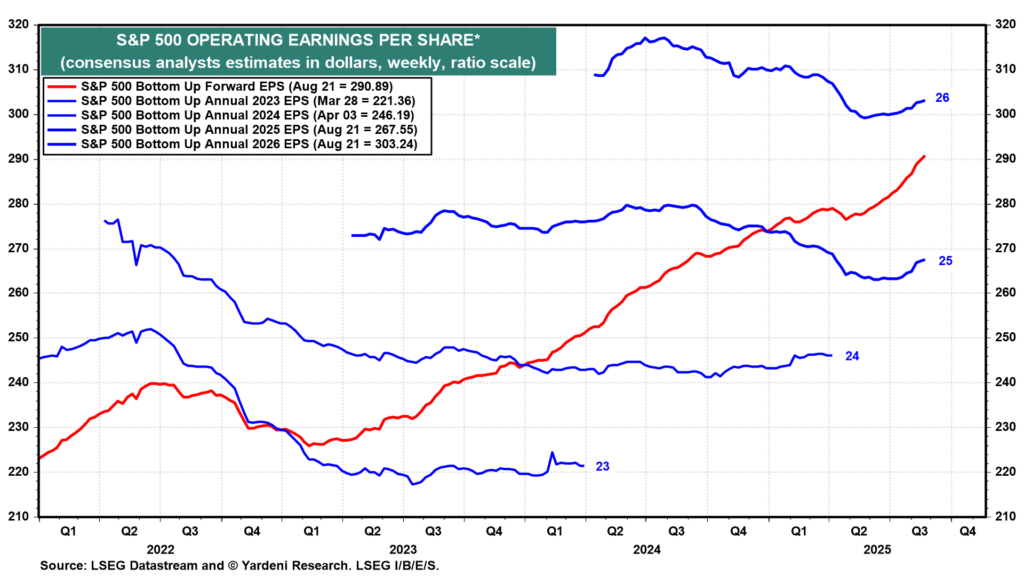1. Earnings Still Trending Higher
EPS outlook. “S&P 500 forward earnings per share rose to yet another new record high during the week of August 21 as industry analysts raised their 2025 and 2026 earnings estimates.”

2. NVDA Earnings Post Close Wed….History of Post-Earnings

Dorseywright
3. Chat GPT Threat to Google Search? Google New Highs

StockCharts
4. Google Outperforming MSFT Since Chat GPT Launch

Bespoke
5. In Small Caps Last 5 Years….Value has Been Outperforming Growth

Y Charts
6. Nvidia’s new ‘robot brain’ goes on sale for $3,499 as company targets robotics for growth-CNBC
Key Points
- Nvidia announced on Monday that its latest robotics chip module, the Jetson AGX Thor, is now on sale for $3,499 as a developer kit.
- The company calls the chip a “robot brain.” The first kits ship next month, Nvidia said last week, and the chips will allow customers to create robots.
- Nvidia CEO Jensen Huang has said robotics is the company’s largest growth opportunity outside of artificial intelligence.
Nvidia announced Monday that its latest robotics chip module, the Jetson AGX Thor, is now on sale for $3,499 as a developer kit.
The company calls the chip a “robot brain.” The first kits ship next month, Nvidia said last week, and the chips will allow customers to create robots.
After a company uses the developer kit to prototype their robot, Nvidia will sell Thor T5000 modules that can be installed in production-ready robots. If a company needs more than 1,000 Thor chips, Nvidia will charge $2,999 per module.
CEO Jensen Huang has said robotics is the company’s largest growth opportunity outside of artificial intelligence, which has led to Nvidia’s overall sales more than tripling in the past two years.
“We do not build robots, we do not build cars, but we enable the whole industry with our infrastructure computers and the associated software,” said Deepu Talla, Nvidia’s vice president of robotics and edge AI, on a call with
https://www.cnbc.com/2025/08/25/nvidias-thor-t5000-robot-brain-chip.html\
7. COIN -30% from Highs

StockCharts
8. Labor Day Steaks will be Expensive

Barchart
9. San Fran Homeless Citations up 25X
WSJ Last year, the U.S. Supreme Court granted cities more power to penalize people for sleeping outside, handing city leaders a new tool with which to clear homeless people from the streets.

WSJ
10. Appeal to System 1 thinking -INC
Daniel Kahneman, the Nobel Prize-winning psychologist, said the human brain makes decisions based on two ways of thinking, or what he called systems. System 1 is your brain’s autopilot. It assesses a situation quickly without a sense of voluntary control. System 2 takes its time. It’s more logical and deliberate. When people hear a message for the first time, System 1 kicks into action. It decides almost instantly, “Is this useful to me?” If the answer is yes, it pays attention. If the answer is no, it tunes out.
One of the brain’s primary functions is to conserve energy, so it’s constantly scanning its environment to pay attention to those things that matter and ignore the rest. When the brain locks on to something important, System 2 takes over. It will look for logical arguments supported with facts, figures, data, and evidence. System 1, however, acts as the gatekeeper.
The importance of audience-centric communication
In audience-centric communication, it’s critical to make the benefit clear in the first 30 seconds of a presentation. If your listeners have to work too hard to decipher what you say and how it applies to them, you’ve lost their attention. It’s important to make your topic worth their mental energy.
One easy way to get your audience locked in is to start with the benefit, and then back into the topic. For example, when I began a keynote presentation for an AI summit at MIT, I opened with this line: “Full disclosure. I am not here to tell you how to do your job.” Since the audience was made up of researchers who are deeply involved in the field of AI, it was important that I acknowledge the obvious—I’m not an AI scientist.
In my second sentence, just 14 seconds after I took the stage, I said, “I am here to elevate the job you do by giving you specific, tactical tools and techniques that will help you sharpen the most critical leadership skill that you can build today.”
I could have used the first 30 seconds or so to talk about my books, credentials, or experience, but none of those things would have given the audience a reason to care. Those details support my ideas and lend credibility to my argument, but they won’t make it through the System 1 gatekeeper. Play to the gatekeeper first. Once you get your audience to lean in, you’ll have their attention, and they’ll be eager to hear what you say next.
The opinions expressed here by Inc.com columnists are their own, not those of Inc.com.